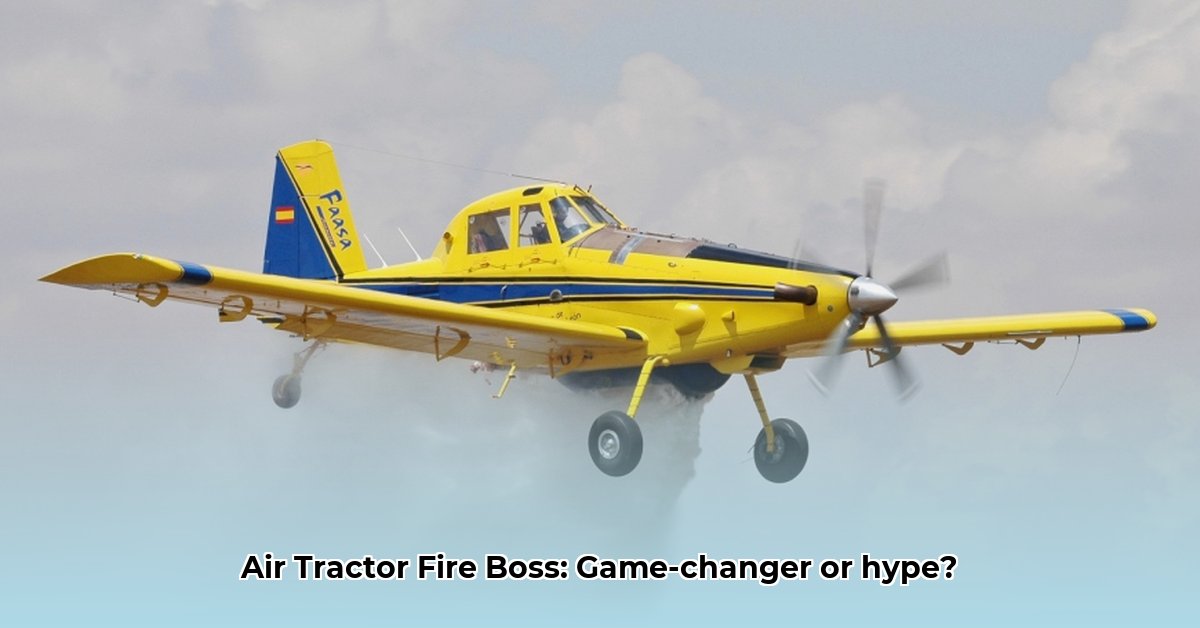
Air Tractor Fire Boss: A Detailed Technical Analysis
The Air Tractor Fire Boss, an amphibious air tanker, represents a significant advancement in wildfire suppression technology. Its ability to rapidly scoop water directly from water sources and deliver it to fire sites offers unparalleled speed and precision in combating fast-moving wildfires. However, understanding its capabilities and limitations is crucial for effective deployment and strategic resource allocation. This analysis provides a comprehensive overview, examining the aircraft's strengths, weaknesses, and the factors influencing its operational efficiency.
Speed, Precision, and Versatility: Core Capabilities
The Fire Boss's primary advantage lies in its speed and precision. Its ability to scoop up 800 gallons of water in under 15 seconds and its cruising speed of 150 knots (approximately 173 mph) allow for rapid response and efficient water delivery to the fire line. The system also enables variable water release, allowing firefighters to adjust the water dispersal pattern to suit specific needs, from powerful bursts to gentle streams (Reference 1). This precision is crucial in mitigating damage to surrounding areas. The aircraft’s versatility extends beyond wildfire suppression; its standard landing gear allows for alternative uses during non-firefighting seasons.
Operational Limitations: Range and Capacity Constraints
While the Fire Boss excels in speed and precision, it has limitations. As a single-engine aircraft with an 820-gallon water tank, its range and payload are smaller compared to larger, twin-engine air tankers. This limitation becomes increasingly apparent over longer distances between water sources and fire locations. Therefore, strategic water source proximity is an essential planning factor. The total water delivered over an operation will be critically affected by this logistical requirement.
Water Source Dependency: A Critical Factor
The effectiveness of the Fire Boss is intrinsically linked to the availability of suitable water sources. Extended travel time to refill significantly reduces the number of sorties (flights) possible within a given timeframe, impacting overall water delivery efficiency. Hence, careful pre-fire planning, including detailed assessment of accessible water sources, directly contributes to successful deployment.
Technological Aspects: Engine and Water Release Systems
The Air Tractor Fire Boss utilizes a powerful Pratt & Whitney PT6A-67F engine, providing reliable high-altitude performance. However, a comprehensive cost-benefit analysis must factor in long-term engine maintenance and lifespan. Furthermore, the various water release systems available for the Fire Boss possess different efficiencies and performance characteristics, necessitating further research to fully understand these variations.
Stakeholder Perspectives and Future Development
The future of the Fire Boss and its role in wildfire suppression hinges on several influential elements. The cooperation and strategic planning of various stakeholders are key to improving its effectiveness.
| Stakeholder | Short-Term Goals (0-1 Year) | Long-Term Goals (3-5 Years) |
|---|---|---|
| Firefighting Agencies | Evaluate regional suitability; prioritize pilot training programs. | Develop comprehensive deployment strategies; explore multi-aircraft coordinated operations. |
| Manufacturers | Improve designs based on real-world data; explore alternative engines. | Invest in R&D for increased water capacity and range; develop advanced scooping technologies. |
| Government Agencies | Fund pilot programs; enhance infrastructure for amphibious operations. | Implement national strategies using various tanker types; incentivize sustainable practices. |
Risk Assessment and Mitigation Strategies
The inherent risks associated with aerial firefighting demand a systematic approach to mitigation. The Fire Boss, as an airborne asset, faces several potential hazards.
| Risk Factor | Likelihood | Impact | Mitigation Strategy |
|---|---|---|---|
| Engine Failure | Low | Catastrophic | Rigorous maintenance; advanced safety systems; backup plans |
| Water Source Depletion | Moderate | High | Careful planning; real-time monitoring; alternative water sources identified |
| Mechanical Malfunction | Low | Moderate | Regular inspections; preventative maintenance; quick repair procedures |
| Adverse Weather | Moderate | Moderate | Weather forecasting; flexible operations; safety protocols |
| Pilot Error | Low | Catastrophic | Extensive training; flight simulators; strict adherence to procedures |
Regulatory Compliance and Environmental Impact
Adherence to FAA regulations concerning amphibious operations, engine certifications, safety standards, and environmental considerations is paramount and requires ongoing monitoring and investigation.
Conclusion: A Valuable Tool within a Broader Strategy
The Air Tractor Fire Boss provides a significant advantage in rapid response and precise water delivery during wildfire suppression. However, its range and payload limitations necessitate strategic deployment choices. Its effectiveness is heavily dependent on proximity to adequate water sources, meticulous planning, and proper operational execution. Continued research and development are essential to maximize its potential and improve its integration within a broader, multi-faceted wildfire suppression strategy.
Reference: